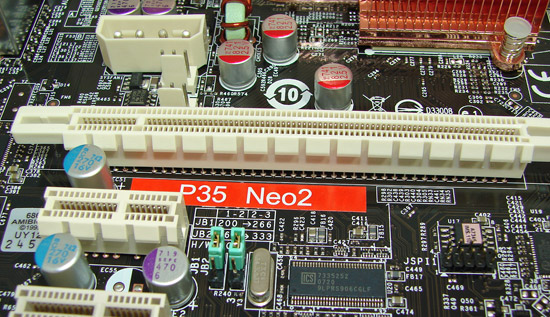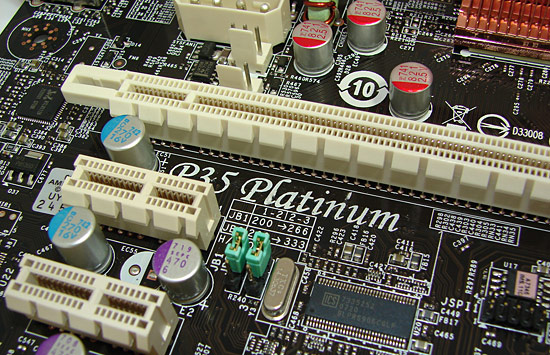MSI P35 Neo2-FR: Platinum performance for under $100
by Gary Key on December 5, 2007 11:00 PM EST- Posted in
- Motherboards
We have not heard that much from MSI lately. Yes, they always seem to launch product at the same time as ASUS and Gigabyte, but their product launches always seem subdued. Their marketing program does not usually have the all-out blitz we typically see from ASUS or Gigabyte, or their product lineup may lack a killer feature. We know MSI is there - in fact, not a day goes by without us discussing products or technology with them - so what's the problem? It comes down to having a product design or feature that differentiates MSI from the other suppliers. No, we are not talking about roller coaster designed heatpipes; we are talking about product that outperforms the competition at launch or can make a difference in how you use or perceive the value of the product.
We have seen a great deal of improvement in MSI's motherboard products over the course of the last year. Their layouts have improved and in fact, we absolutely love the layout on the new K9A2 Platinum board that uses AMD's new 790FX chipset. MSI also offers the Creative Lab's X-Fi audio codecs on their high-end boards as a nod to the gaming community. In addition to unique layouts or features, their overall product quality and commitment to performance has been steadily improving. Our problem with MSI the past few product launches has not centered on them being late to market or not having compelling product alternatives. It has come down to basic performance, compatibility, and BIOS features that leave a lot to be desired when comparing them to the likes of ASUS or Gigabyte. We witnessed this with the P35 launch last spring and again with the 790FX a couple of weeks ago. Their boards are solid and perform well at launch; only the BIOS releases have been weak. The difference we are seeing now is that MSI is quickly resolving problems, and they continue to provide support and updates over the lifespan of the product.


Identical or Fraternal Twins?
The other difference is that MSI is starting to offer a compelling value in certain market segments. One such market segment is the quickly growing budget performance sector, which is now moving to Intel's P35 chipset. The initial launch of the P35 chipset featured boards in the $200 and up price grouping from ASUS, Gigabyte, and MSI. MSI's offering, the P35 Platinum, was at the low end of this sector but did not offer a very good price to performance ratio when compared to the other boards. This changed greatly a few weeks after its release with the P3 performance-oriented BIOS. However, there was an eerie silence at the time as abit had just introduced the similarly priced and very impressive IP35-Pro to a thunderous roar from the user community.
With the introduction of the X38 chipset and the widespread adoption of P35 across a variety of products, we are now seeing incredible competition in the budget to midrange markets. As competition has increased, prices have decreased and the selection of performance-oriented motherboards for under a $130 is incredible. We say this considering the typical prices that usually accompany Intel chipsets. What is even more amazing is the level of performance and features that a user can purchase for under $100 now. We are not talking about the P965 or 945P based boards, but boards designed around the P35 chipset.
MSI offers a base P35 board for around $72, but that board like other budget designs is suited for SOHO users. What excites us in the under $100 performance market are boards like the abit IP35-E and Gigabyte GA-P35-DS3L. Recognizing this trend, MSI developed the Neo2 series. In actuality, they did not have to do too much development; the Neo2-FR/FIR is just a rebadged P35 Platinum with a couple of features missing. MSI is not really hiding this fact; the user can easily remove the Neo2 label to see the Platinum silk screen. The features missing are not extensive either; the FR board drops FireWire and an S/PDIF Optical out port while the FIR is only missing the Optical out port.
Fortunately, for us the performance remains the same, as does the support, features, and quality. The only difference is the almost $40 reduction in price, something we can all use. Let's look at the MSI Neo2-FR feature set and performance results. Our findings might just make you sit up and take notice of MSI again.










35 Comments
View All Comments
krunt - Saturday, January 12, 2008 - link
so when can we expect the shoot out between the "cheap" boards? it has been two months since it was said to be here shortly.nefar - Sunday, December 23, 2007 - link
It drives me crazy when a site claims a price and then it turns out it's with a "rebate". Unless I can go buy the item under $100.00 it's not under $100.00 and it should not be shown as such.thebittersea - Sunday, December 9, 2007 - link
This is a great article with a lot of AnandTech caliber content. However, I have one problem with the fluff that plagues your write up. I'm not sure if you have to reach a certain pages to get the amount of ads to keep this place going, but I find that informations are being repeated over and over again. The conclusion (which I always read first), can definitely be summarized in less than two paragraphs.I love your site!
nermanater - Saturday, December 8, 2007 - link
Just as a side note, there is no such thing as CAL P...there is cevo-p but if you were in that league you wouldn't make that mistake. Sound is extremely important to serious gamers and onboard just doesn't cut it sometimes.rallyhard - Friday, December 7, 2007 - link
On page five:"The problem is that once we started to raise the FSB over 445 with the Q6600 or QX6850 processors, the board automatically (drastically) reduced chipset timings and memory sub-timings"
Shouldn't that be an increase in timings? A reduction would be a good thing, right?
JarredWalton - Friday, December 7, 2007 - link
"reduced" as in "changed in a bad way that results in reduced performance" is the idea. Yes, the timings/sub-timings are probably getting higher. I think it also changes the FSB strap (Gary can confirm). So basically, you're better off with a lower FSB/higher multiplier, which gives improved performance.takumsawsherman - Thursday, December 6, 2007 - link
This seems to have very few ports on it, not to mention zero firewire. In bulk, adding firewire to a board can't be *that* expensive.just4U - Thursday, December 6, 2007 - link
I am glad you folks here at Anandtech did a review on this board. I've set up a few computers now based around it and I was so impressed I accually want one for myself. When I recommend it to others it's like being in a very quiet forest as no one really knows much about it.I accually liked the little led display they have to. Looks good in a windowed case and is very subtle.
Anywhoo Good review!
ultimatex - Thursday, December 6, 2007 - link
Toms and Hardocp have done reviews of this board and its always scores higher or the same as those $200.00 boards.I did tons of research comparing it to the Asus and Gygabyte ones that cost the same and went with this one because off all the benchmarks ive seen. Plus it looks better than any board at $120.00
Anyone know if theres any way to soder a optical outlet on this board and if it will work.
j@cko - Thursday, December 6, 2007 - link
The title "performance for under $100" is misleading; because without the rebate, this board is >$100 and the rebate is time limited. Unless MSI is due to a price cut soon.